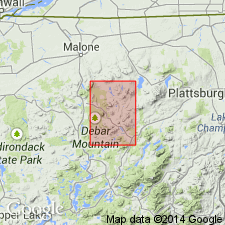
- Usage in publication:
-
- Hawkeye granite gneiss*
- Modifications:
-
- Revised
- AAPG geologic province:
-
- Adirondack uplift
Summary:
Pg. 8-10, 37 (table), pl. 1. Hawkeye granite gneiss. Termed granite gneiss. Has pronounced phacoidal texture; strongly foliated. Miller described Hawkeye granite as a facies of his Lyon Mountain granite, but it is here considered to be an older spearate unit. Interpreted as having been intruded into original Grenville series. Age is Precambrian.
Source: US geologic names lexicon (USGS Bull. 1200, p. 1705-1706).

- Usage in publication:
-
- Hawkeye granite gneiss*
- Modifications:
-
- Mapped 1:62.5k
- Dominant lithology:
-
- Granite gneiss
- AAPG geologic province:
-
- Adirondack uplift
Summary:
Hawkeye granite gneiss described and mapped in Loon Lake quadrangle. Commonly a dark-greenish coarse well-foliated phacoidal-textured rock composed of quartz and feldspar, with lesser amounts of pyroxene, hornblende, and biotite. In some areas, lacks planar foliation and is rod or pencil gneiss. Locally fresh rock is pink instead of greenish. Age is Precambrian.
Source: US geologic names lexicon (USGS Bull. 1200, p. 1705-1706).
For more information, please contact Nancy Stamm, Geologic Names Committee Secretary.
Asterisk (*) indicates published by U.S. Geological Survey authors.
"No current usage" (†) implies that a name has been abandoned or has fallen into disuse. Former usage and, if known, replacement name given in parentheses ( ).
Slash (/) indicates name conflicts with nomenclatural guidelines (CSN, 1933; ACSN, 1961, 1970; NACSN, 1983, 2005, 2021). May be explained within brackets ([ ]).

